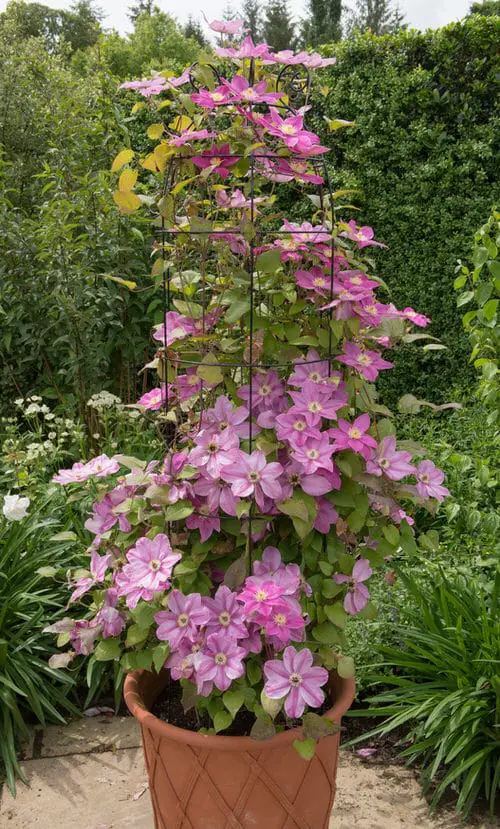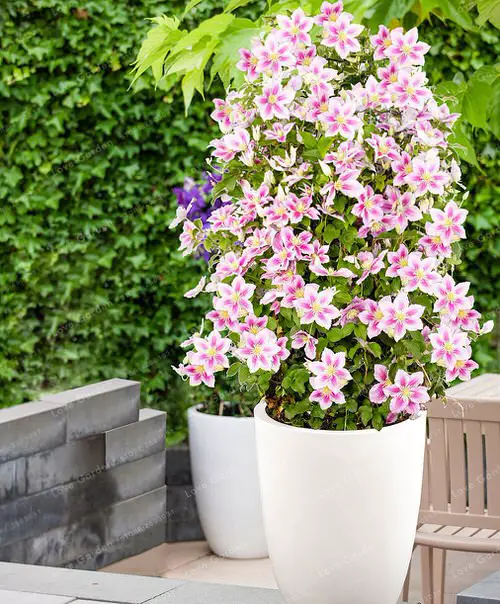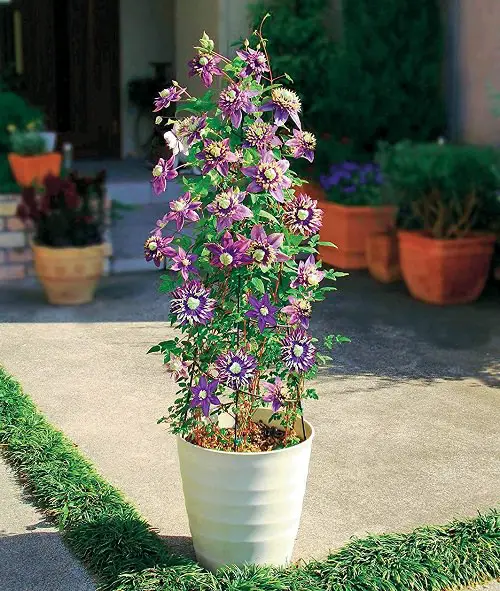Here’s everything about How to Grow Clematis in a Pot and have the beautiful blooms of the Queen of Climbers on your patio or balcony!
Leather flower or Clematis is a hardy climbing vine with masses of attractive blooms of solid colors and dual shades ranging from white to reds, or pale pastels to dark purples. If you too want to have this plant in your home, then here’s all you need to know about How to Grow Clematis in a Pot!

Botanical Name: Clematis
USDA Zones: 4-9
Common Names: Clematis Javana, Western blue virginsbower, Traveller’s joy, Leather Flower.
Have a look at the best types of Clematis to grow here
About Clematis Plant
Clematis is one of the most popular and beautiful flowering climbers grown in homes, either indoors or outdoors. Though mostly all species of Clematis blooms between early spring and autumn, the species varies widely on the shape of the flowers, colors, and growing seasons, too.
Depending on the type you choose to plant, its growing needs would vary but most of them have similar basic needs to grow.
Best Clematis Varieties For Pots

1. Sieboldii
USDA Zones: 4-8
This dwarf variety, with purple-centered creamy white flowers, is surely an attractive choice for your home!
2. Polish Spirit
USDA Zones: 4-11
Another compact Clematis type with rich violet-blue blooms from summer to early fall.
3. Nelly Moser
USDA Zones: 4-9
This variety produces a mass of gorgeous huge purple-pink-colored flowers in the shape of a star.
4. The President
USDA Zones: 4-8
This deciduous vine produces deep violet-blue, star-shaped flowers with pink to deep red-colored filaments.
5. Josephine
USDA Zones: 4-9
This variety of Clematis is one of the most popular for growing in containers. With its pom-pom blooms in deep mauve to pink shades that last up to 4-5 weeks.
6. Arctic Queen
USDA Zones: 4-9
The large-sized double heads, it flowers in white shade from June to September.
7. Viticellas
USDA Zones: 4-8
It is one of the easiest Clematis to care for. The plant is mostly happy in a wide range of soil types and is also wilt-resistant.
Choosing a Pot for Clematis
Make sure to use a 16-18 inches pot for Clematis as the excess amount of soil in the container will aid in protecting the roots of the plant during winters and hot summers. The planter should have enough drainage holes at the bottom as the roots do not prefer wet feet.
How to Grow Clematis in a Pot
The best way to propagate clematis in pots is by cuttings. Take a 4-6 inches long cutting from a healthy plant in April or May. Take out all the lower leaves, and plant it in a pot filled with a good quality potting mix. Cover the pot with a clear plastic bag, and keep it in a warm spot, away from direct sunlight. The cutting will root in about 5-7 weeks.
To save time, you can also get a well-grown plant from a nursery.
Best Time to Plant Clematis
Spring or the fall is the best time of the year to plant Clematis. You can also choose to grow the plant during summers but it will need extra attention, care, and love in the hot climate!
Requirements for Growing Clematis in Pots

Location
The plant is happy in a spot that receives full and direct sunlight for about 6-8 hours every day that helps the plant produce maximum blooms all year round. While growing indoors, go for a south-facing window.
Soil
Clematis loves well-draining and moist soil that is either neutral or slightly alkaline. Adding a bit of compost or manure to the growing medium will also give it the right boost.
Adding a layer of mulch is also a good idea, as it will help in moisture retention, extra nourishment to the roots, and added protection during winters.
Watering
You need to bear in mind that while growing in containers would need more watering, as pots tend to dry out much faster. Make sure you water the plant before it dries off completely. Keep a check on the topsoil during the hot days of summer – you might need to increase the frequency of watering.
Temperature
This plant is happiest with warm, direct sun on its foliage. It does best in the temperature range of 64-94 F (18-34 C). In warmer climates, it is recommended to provide a partial shade to the plant.
Clematis Plant Care

Fertilizer
If you have added compost or manure while planting clematis, you do not have to worry much about adding any fertilizer for the first year. After the plant gets established, feed it with 5-10-10 mix, once a year, during spring.
Alternatively, you can also use a balanced 10-10-10 mix, once every 6-8 weeks, until the end of the growing period. Make sure to refer to the label for dosage.
Pruning
Prune the plant just after when it finishes flowering. In case your clematis flowers in mid-spring or later, prune in early spring before the buds swell up and begin to grow.
Also, watch out for any dead, damaged, or weak stems and trim them. Indulge in a regular pruning routine to prevent the plant from becoming a knotted mass.
Support
After you plant clematis in a pot, make sure you have given it the right support system. It is crucial to do it at the time of planting so the roots could develop properly.
The plant finds easier to grab onto fishing line, thin wires, branches, steel rods, twine, or wooden dowels because of its thin tendrils. It is for the best to provide them with more than one option to hold onto. So, if you already have a trellis, you can consider adding some more options.
Pests and Diseases
Thankfully, clematis is not susceptible to any pests. Wilting and some fungal diseases like powdery mildew can affect the plant during hot and humid climates. You can use neem oil or baking soda with water to keep the issues at bay.
Winter Care For Clematis in Pots
Shift the pot to a warmer location during winters. Make sure that it is not too hot as the plant will need a bit of cold to go into a dormant state.
Choose a type that’s best suited to the USDA zone you live in. This could help you make sure that the plant survives the harsh winter in your area.


